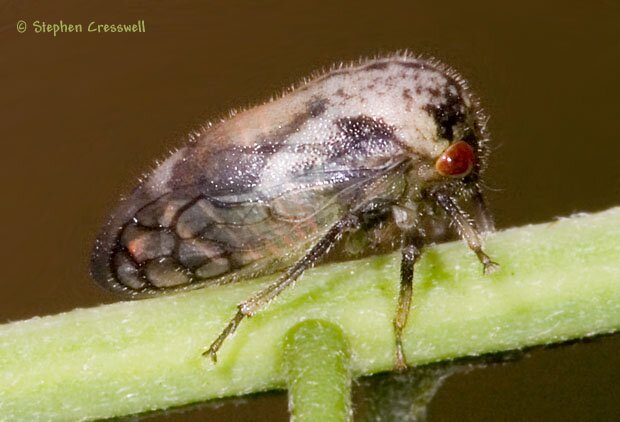
Family: Membracidae
Subfamily: Smiliinae
Length: females typically 5.7-5.8 mm, males about one mm shorter
Black Locust is the only plant on which Vanduzea arquata can lay its eggs and have its nymphs develop.
Funkhouser (1915) provided an especially detailed life history of Vanduzea arquata, based on his extensive notes of five years of observations made near Ithaca, New York.
The species overwintered in the egg stage, the eggs inserted in the bark of Black Locust near the tree's base. Nymphs first appeared around May first (in New York).
Funkhouser gave the duration of each instar as a range, namely 5-8 days for the first instar, and the remaining instars 3-5, 3-5, 3-6, and 5-10 days, depending on weather conditions. Overall, egg to adult took 18-33 days, and averaged 21 days.
In his New York study area Funkhouser reported up to four broods per year.
Adults, nymphs, and ants live together in an aggregation near the base of a twig, typically in a sunny location. Funkhouser reported that unlike most other treehoppers, this species is most at home on the upper sides of branches; he noted that adults "are very seldom found on the leaves and never on the trunk."
Funkhouser stated that in northern New York adults are common from early June to late October, easily tolerating heavy frost and sometimes "surprisingly active after the first few snows." Late in the season the males outnumber females by a ratio of five to one, which the author noted was in contrast to another Locust treehopper, Thelia bimaculata, where males disappear late in the season while females live on.
In his five years of diligent observation, Funkhouser noted a number of species preying on the adults or nymphs of Vanduzea arquata, including spiders, robber flies, and a mantis. He described watching a Chipping Sparrow "industriously searching for the immature forms but neglecting the adults. The latter are probably sufficiently protected bird enemies by the hard pronotum and sharp posterior process." Presumably the attending ants could do little to deter a determined sparrow.
Elsewhere on the Insects of West Virginia site are Funkhouser's drawings of the nymphs of Vanduzea arquata, as well as photos of the nymphs.

Nault, Wood, and Goff (1974) reported that when attacked Vanduzea arquata gives off an alarm pheromone that causes the other hoppers in the aggregation to disperse. Unfortunately for the the attacked hopper, the pheromone is only released when the predator punctures the body wall.
West Virginia has no published records of Vanduzea arquata, but these photos were taken in May and June 2006 at a highway department wetland in Upshur County.
 |
 |



